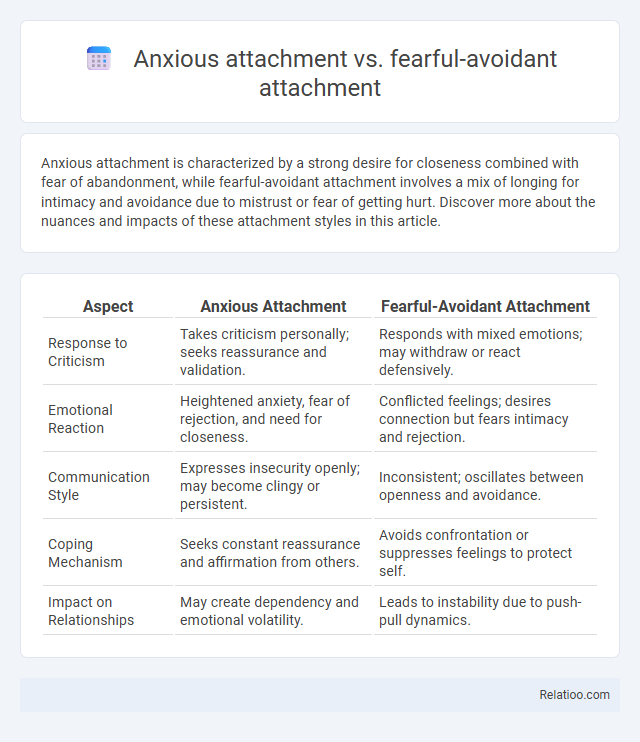Anxious attachment is characterized by a strong desire for closeness combined with fear of abandonment, while fearful-avoidant attachment involves a mix of longing for intimacy and avoidance due to mistrust or fear of getting hurt. Discover more about the nuances and impacts of these attachment styles in this article.
Table of Comparison
| Aspect | Anxious Attachment | Fearful-Avoidant Attachment |
|---|---|---|
| Response to Criticism | Takes criticism personally; seeks reassurance and validation. | Responds with mixed emotions; may withdraw or react defensively. |
| Emotional Reaction | Heightened anxiety, fear of rejection, and need for closeness. | Conflicted feelings; desires connection but fears intimacy and rejection. |
| Communication Style | Expresses insecurity openly; may become clingy or persistent. | Inconsistent; oscillates between openness and avoidance. |
| Coping Mechanism | Seeks constant reassurance and affirmation from others. | Avoids confrontation or suppresses feelings to protect self. |
| Impact on Relationships | May create dependency and emotional volatility. | Leads to instability due to push-pull dynamics. |
Understanding Attachment Styles
Anxious attachment is characterized by a strong desire for closeness paired with fear of abandonment, leading to heightened emotional dependency and sensitivity to rejection. Fearful-avoidant attachment combines an intense fear of intimacy with a desire for connection, often resulting in mixed emotions and unpredictable relationship behaviors. Understanding these attachment styles is crucial for recognizing patterns in relational dynamics and promoting emotional healing and secure bonding.
What is Anxious Attachment?
Anxious attachment is characterized by a strong desire for closeness combined with fear of abandonment, often leading to clinginess and heightened sensitivity to relationship dynamics. Fearful-avoidant attachment shares the fear of intimacy and rejection but includes a tendency to avoid emotional closeness as a self-protective mechanism. Understanding these distinctions highlights that anxious attachment primarily involves seeking reassurance, while fearful-avoidant individuals struggle with conflicting desires for both connection and distance.
What is Fearful-Avoidant Attachment?
Fearful-avoidant attachment is characterized by a combination of anxiety and avoidance in relationships, where individuals intensely desire closeness but simultaneously fear intimacy and rejection. This attachment style often leads to emotional confusion, inconsistent behaviors, and difficulty in trusting others. Understanding your attachment style, especially fearful-avoidant attachment, is crucial for improving relationship dynamics and emotional well-being.
Key Differences Between Anxious and Fearful-Avoidant Attachment
Anxious attachment is characterized by a strong desire for closeness and fear of abandonment, often leading to clinginess and seeking constant reassurance. Fearful-avoidant attachment combines the fear of intimacy found in avoidant attachment with the anxiety about relationships seen in anxious attachment, causing individuals to both desire and avoid closeness simultaneously. Your understanding of these key differences can improve how you manage relationship dynamics and emotional responses.
Core Symptoms and Behaviors
Anxious attachment is characterized by intense fear of abandonment, excessive need for reassurance, and heightened emotional sensitivity, leading to clingy and dependent behaviors. Fearful-avoidant attachment combines anxiety and avoidance, with core symptoms including fear of intimacy, mistrust, and ambivalence, resulting in contradictory behaviors such as seeking closeness but simultaneously pushing others away. Both types exhibit emotional dysregulation, but anxious attachment primarily manifests through anxiety-driven pursuit, while fearful-avoidant attachment involves oscillation between approach and avoidance behaviors.
Origins and Childhood Influences
Anxious attachment arises from inconsistent caregiving, where Your caregivers' unpredictable responses lead to heightened fear of abandonment and excessive need for reassurance. Fearful-avoidant attachment combines the desire for closeness with deep-seated fear of rejection, often stemming from trauma or neglect in childhood that instills both attachment and avoidance tendencies. Anxious attachment, primarily rooted in early childhood experiences of emotional unavailability, shapes Your adult relationships through heightened sensitivity to perceived threats in intimacy.
Impact on Adult Relationships
Anxious attachment often leads to intense relationship anxiety and a fear of abandonment, causing individuals to seek constant reassurance and exhibit clingy behaviors that strain intimacy. Fearful-avoidant attachment combines a desire for closeness with fear of intimacy, resulting in mixed signals, emotional unpredictability, and difficulties in establishing trust. Both attachment styles negatively impact adult relationships by creating cycles of dependency and withdrawal, undermining emotional stability and effective communication.
Emotional Triggers and Coping Mechanisms
Anxious attachment often involves emotional triggers such as fear of abandonment and excessive need for reassurance, leading to coping mechanisms like seeking constant validation and heightened sensitivity to partner cues. Fearful-avoidant attachment combines contradictory desires for closeness and avoidance, triggered by fears of rejection and intimacy, resulting in coping strategies such as emotional withdrawal and ambivalence in forming bonds. Understanding the nuances between anxious and fearful-avoidant attachment styles is crucial for tailoring therapeutic interventions that address specific emotional triggers and promote healthier relationship dynamics.
Healing and Secure Attachment Development
Healing anxious attachment involves developing self-awareness and emotional regulation techniques to reduce dependency and increase trust in relationships. Fearful-avoidant attachment requires addressing deep-seated fears of rejection through trauma-informed therapy and gradual exposure to vulnerability, fostering safety and connection. Cultivating secure attachment centers on consistent, responsive interactions that build confidence and emotional resilience, enabling healthier relationship patterns.
Therapy and Support Options
Therapy for anxious attachment often involves cognitive-behavioral techniques to build self-esteem and improve emotional regulation, while fearful-avoidant attachment treatment focuses on addressing deep-seated trust issues and trauma through trauma-informed therapy like EMDR or schema therapy. Support options for anxious attachment include group therapy and mindfulness practices that enhance emotional awareness, whereas fearful-avoidant individuals benefit from consistent therapeutic relationships and attachment-based interventions to foster security. Combining individual therapy with peer support groups provides a comprehensive approach for both attachment styles, promoting healthier relationship patterns and emotional resilience.

Infographic: Anxious attachment vs Fearful-avoidant attachment
 relatioo.com
relatioo.com